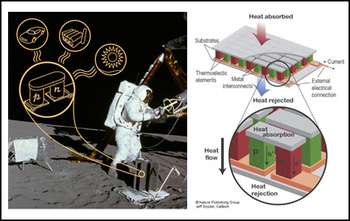Researchers develop high-performance bulk thermoelectrics

(PhysOrg.com) -- Roughly 10 billion miles beyond Neptune's orbit, and well past their 30th birthdays, Voyagers 1 and 2 continue their lonely trek into the Milky Way. And they're still functioning—running on power gleaned not from the pinprick sun, but from solid-state devices called thermoelectric generators, which convert heat energy into electricity.
The same technology can be applied here on Earth to recover waste heat when fuel is burned. "Cogeneration," or the production of electricity as a by-product of a heat-generating process, already provides as much as 10 percent of Europe's electrical power. Systems for this purpose typically operate best at very high temperatures, are costly to build and operate, and suffer from substantial inefficiencies. That's why they can be found in spacecraft and power plants but not, say, in cars.
But recently, scientists have concocted a recipe for a thermoelectric material that might be able to operate off nothing more than the heat of a car's exhaust. In a paper published in Nature this month, G. Jeffrey Snyder, faculty associate in applied physics and materials science at the California Institute of Technology (Caltech), and his colleagues reported on a compound that shows high efficiency at less extreme temperatures.
The heart of a thermoelectric generator is a flat array of semiconductor material. In operation, heat from an external source is directed against one side of the array, while the other side is kept cool. Like air molecules in a hot oven, the material within the array flows along the induced temperature gradient: away from the hot side and toward the cool side. But in the crystalline lattice of a semiconductor, there's only one "material" that isn't rigidly fixed: the charge carriers. Consequently, the only things that move in response to the thermal nonequilibrium are these charge carriers and the result is an electrical flow. Build up a circuit by laying out small semiconductor bricks side by side and wiring them together, and you've got a steady electric current.
The lead telluride (PbTe) family of compounds is commonly used in these applications, but regardless of the underlying technology, scientists designing new thermoelectric materials are continually constrained by structural issues at the most microscopic levels. Those moving charge carriers can run afoul of many complex effects, including electrical interactions, heat-induced vibrations (called phonons), and scattering caused by impurities and imperfections within the crystal structure.
The Caltech researchers began with lead telluride and then added a fractional amount of the element selenium, a concoction first proposed by Soviet scientists A. F. Ioffe and A. V. Ioffe in the 1950s. Because any semiconductor's properties are highly sensitive to the exact type and placement of each of its atoms, this small alteration in the formula produces important changes in the crystal's electronic structure.
Specifically, certain regions called "degenerate valleys" arrange themselves in such a way as to provide a more favorable pathway for charge carriers to follow, a trail of equal-energy stepping stones through the material. In addition, adding the selenium creates multiple regions called point defects. "They're like air bubbles trapped in window glass," says Snyder, "and they tend to scatter vibrations. The result is that heat dissipates more slowly through the material."
That dissipation is important, because in order for a material to be efficient, charge carriers should flow much more easily than heat. In other words, electrical resistance should be low, to maximize current, while thermal resistance should be high, to maintain the temperature gradient that causes the charge carriers to flow in the first place. "It's a delicate tradeoff," says Snyder. "Something like trying to blow ice cream through a straw. If the straw's very narrow, the ice cream moves slowly. But if you widen it to help the ice cream move faster, you'll find that you also run out of air faster."
To make sense of these tradeoffs, scientists speak of a quantity known as the "thermoelectric figure of merit," a dimensionless value that can be used to compare the relative efficiency of materials at specific temperatures. The temperature at which peak efficiency is seen depends on the material: each of the Voyager twins, for instance, produces enough juice to power a medium-sized refrigerator, but to do so it must draw heat from decaying radioisotopes. "These new materials are roughly twice as effective as anything seen before, and they work well in a temperature range of around 400 to 900 degrees Kelvin," says Snyder. "Waste heat recovery from a car's engine falls well within that range."
In other words, the heat escaping out your car's tailpipe could be used to help power the vehicle's electrical components—and not just the radio, wipers, and headlights. "You'll see applications wherever there's a solid-state advantage," Snyder predicts. "One example is the charging system. The electricity to keep your car's battery charged is generated by the alternator, a mechanical device driven by a rubber belt powered by the crankshaft. You've got friction, slippage, strain, internal resistance, wear and tear, and weight, in addition to the mechanical energy extracted to make the electricity. Just replacing that one subsystem with a thermoelectric solution could instantly improve a car's fuel efficiency by 10 percent."
As more automotive systems continue their gradual migration from mechanical or hydraulic to electrical—power steering and brakes, for instance, can both be made to run on electricity—the vehicle of the future will sport more than a passing commonality with the spacecraft of the 1970s. "The future of automobiles is electric," says Snyder. "What we're doing now is looking at how to make it all more efficient."
More information: Snyder's coauthors on the paper, "Convergence of electronic bands for high performance bulk thermoelectrics," are Yanzhong Pei, Aaron LaLonde, and Heng Wang of Caltech; and Xiaoya Shi and Lidong Chen of the Shanghai Institute of Ceramics, Chinese Academy of Sciences.
Provided by California Institute of Technology


















